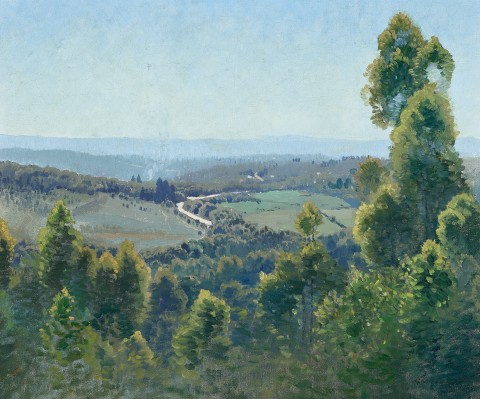THE WHITE ROAD, MT LOFTY, S.A., 1926
ELIOTH GRUNER
oil on canvas
51.5 x 61.5 cm
signed and dated lower right: GRUNER / 1926
Macquarie Galleries, Sydney
Dr H. C. Moxham, Sydney, acquired from the above in 1926
Lawsons, Sydney, February 1945 (as ‘The White Road, Mt. Lofty, S.A.’)
Commercial Banking Company, Sydney
The National Australia Bank Art Collection, acquired from the above in 1982 (label attached verso)
Exhibition of Oil Paintings by Elioth Gruner, Macquarie Galleries, Sydney, 10 – 21 August 1926, cat. 26 (as ‘October Morning’)
Loan Exhibition of the Works of Elioth Gruner, National Art Gallery of New South Wales, Sydney, 21 December 1932 – 21 February 1933, cat. 80
Ashton, H., ‘Gruner’s Pictures. Progress and Honesty. Searching for Facts’, The Sun, Sydney, 10 August 1926, p. 8 (as ‘October Morning’)
MacNally, J., 'Elioth Gruner. Notable Exhibition', The Daily Telegraph, Sydney, 11 August 1926, p. 5 (as 'October Morning')
'Oil Paintings. Mr. Gruner's Exhibition', Sydney Morning Herald, Sydney, 11 August 1926, p. 10 (as 'October Morning')
McCrae, H., ‘Homage to the Greatness of Gruner’, Sunday Times, Sydney, 15 August 1926, p. 2 (as ‘Morning on Mount Lofty’)
Burdett, B., 'The Later Work of Elioth Gruner', in Ure Smith, S., and Gellert, L. (eds.), Art in Australia, Sydney, 3rd series, no. 27, March 1929, Ure Smith, Sydney, pl. 28, p. 85 (illus.)
‘Sundry Shows’, The Bulletin, Sydney, 28 February 1945, p. 2 (as ‘The White Road, Mt. Lofty, S.A.’)
Piccadilly Valley, 1926, oil on canvas, 62.5 x 76.2 cm, in the collection of the Art Gallery of South Australia, Adelaide
We are grateful to Steven Miller, Head of the Edmund and Joanna Capon Research Library and Archive, Art Gallery of New South Wales, for his assistance with this catalogue entry.
By the early 1920s, Elioth Gruner was a celebrated name in Australian painting. With his friend Howard Hinton’s financial assistance, he travelled to London in 1923, and once there, was co-opted reluctantly to manage the Exhibition of Works of Australian Artists, a sprawling exhibition dominated by pastorals and landscapes, including those of Gruner. However, he used his free time to repeatedly explore the National Gallery, where Lloyd Rees encountered him ‘studying a Claude Lorraine, and on becoming aware of my presence he traced the whole outline of a tree with his fingered and murmured quietly, ‘How Claude must have loved that edge.’’1 Gruner’s tastes were an extension of his training under Julian Ashton, as well as his position within the circle of Norman Lindsay, an avowed anti-modernist. What is remarkable is that after London, Gruner travelled to France where he closely studied paintings by Cézanne and Gauguin, whom Lindsay derided as being ‘obscene’. It seems he may also have crossed paths with Roy de Maistre who was also then in Europe as a small oil She oaks in France, 1924 (private collection), is markedly different to Gruner’s previous style and could be mistaken for a de Maistre from the same period.
After his return to Australia in 1925, his subsequent paintings put a new emphasis ‘on structure, pattern and rhythm of forms in the landscape.’2 The White Road, Mt. Lofty, South Australia, 1926, is one of these and gallery audiences immediately responded when Gruner exhibited the new works at the Macquarie Galleries in Sydney in August 1926, with the result that the show was almost sold out in two days. In the previous months, he had travelled extensively though the countryside, mostly alone and camping out, often staying for days in a chosen location, studying and sketching it from many angles. Towards the end of 1925, he took an extended journey to Adelaide, staying in ‘in secluded circumstance,’3 where he painted The White Road, Mt. Lofty, South Australia. The vista is located near to the city and Gruner worked en plein air over some days, using the white road itself as the centre-anchoring motif. The influence of Cézanne in the foreground is pronounced through the individual strokes of colour as Gruner seeks to delineate each leaf in the trees, creating the ‘insinuation of an unseen thing… the wind… advancing over a forested valley. The strong leaves sprang backwards and forward as if controlled by steel springs, while the young ones fluttered in millions so far as the eye was able to see.’4 The painting’s original, exhibited title was ‘October morning’, suggesting this was the month when the work was initially completed before he left the location. However, the 1926 signature and date indicates that he must have worked on it again at a later stage before finishing.
The Art Gallery of New South Wales purchased the brooding Man and mountains from the Macquarie Galleries exhibition, joined the following year with a donation of The pines by Howard Hinton. The White Road, Mt. Lofty, South Australia, exhibited as ‘October morning’, and the accompanying sketch, were singled out by the Daily Telegraph’s critic who considered them ‘quite the best in the display.’5
1. Rees, L., The Small Treasures of a Lifetime: Some early memories of Australian art and artists, Collins, Sydney, 1969, p.120
2. Clark, D., Elioth Gruner: Texture of light, Canberra Museum and Gallery, ACT, 2014, p.7
3. Burdett, B., 'The Later Work of Elioth Gruner', Art in Australia, (Gruner edition), Sydney, 3rd series, no.27, 1 March 1929, n.p.
4. McRae, H., ‘Homage to greatness of Gruner’, Sunday Times, Sydney, 15 August 1926, p.2. McRae was describing the companion work Morning on Mt. Lofty, 1926.
5. MacNally, J., ‘Elioth Gruner. Notable Exhibition’, The Daily Telegraph, Sydney, 11 August 1926, p.5
ANDREW GAYNOR
